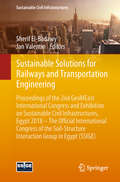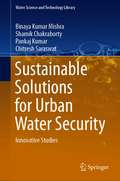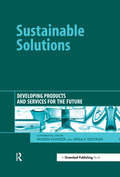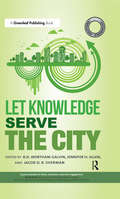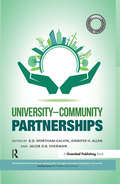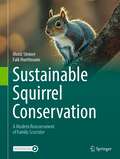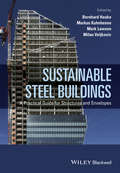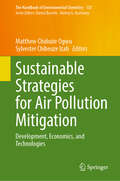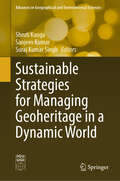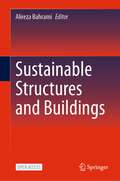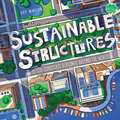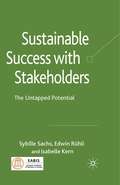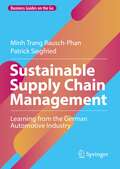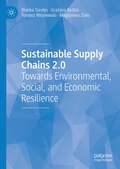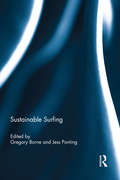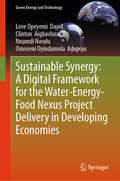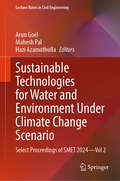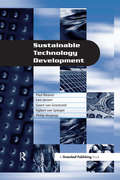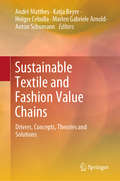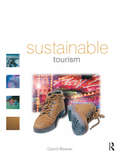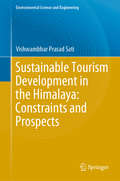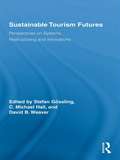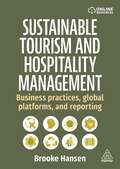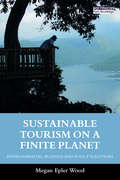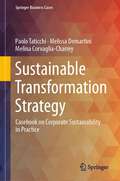- Table View
- List View
Sustainable Solutions for Railways and Transportation Engineering: Proceedings of the 2nd GeoMEast International Congress and Exhibition on Sustainable Civil Infrastructures, Egypt 2018 – The Official International Congress of the Soil-Structure Interaction Group in Egypt (SSIGE) (Sustainable Civil Infrastructures)
by Sherif El-Badawy Jan ValentinThis volume brings together scientific experts in different areas that contribute to the railway track and transportation engineering challenges, evaluate the state-of-the-art, identify the shortcomings and opportunities for research and promote the interaction with the industry. In particular, scientific topics that are addressed in this volume include railway ballasted track degradation/settlement problems and stabilization/reinforcement technologies, switches and crossings and related derailments causes, train-induced vibrations and mitigation measures, operations, management and performance of ground transportation, and traffic congestion and safety procedures. The volume is based on the best contributions to the 2nd GeoMEast International Congress and Exhibition on Sustainable Civil Infrastructures, Egypt 2018 – The official international congress of the Soil-Structure Interaction Group in Egypt (SSIGE).
Sustainable Solutions for Urban Water Security: Innovative Studies (Water Science and Technology Library #93)
by Shamik Chakraborty Pankaj Kumar Binaya Kumar Mishra Chitresh SaraswatThis book presents solutions to address water security in rapidly urbanizing cities, and explores the new paradigms of water security in changing contexts. Highlighting the latest developments in water research, changes in water policy, and current discourses on water security, the book also provides information and tools for local stakeholders, water managers, and policymakers to build the capacity for sustainable water governance. The book discusses a wide range of sustainable solutions and their implementation to ensure that the balance between water supply and demand remains sustainable in the long term, with a focus on local solutions to build capacity and developing policy awareness for a wide range of stakeholders. As the concept of urban water security in changing contexts is open to multiple interpretations, the authors set out various approaches. Providing an overview of the changing perspectives of urban water security in different contexts, the book is based on findings of the Asia-Pacific Network water security project at the United Nations University, Tokyo, as well as the authors' current research-based at Pokhara University, Nepal, Hosei University, Tokyo, Institute for the Global Environmental Strategies, Japan and the Australian National University, Australia. The book also includes the views of international authorities (such as water experts) on the subject. The solutions are complemented by analysis of case studies of various localized sustainable solutions at different scales. The book is a valuable resource for water professionals and policymakers around the globe, academics, teachers working in water-related areas, NGOs, think thanks, water research institutes, donor organizations, and international and local water utility services.
Sustainable Solutions: Developing Products and Services for the Future
by Martin Charter Ursula TischnerToughening environmental legislation, national and supra-national environmental product policies and growing customer demands are focusing the attention of companies on the environmental and broader social issues linked to the creation and delivery of their products and services. There is now an urgent need for appropriate management structures, practical tools and increased awareness among all stakeholders in the product development process and throughout the entire product life-cycle. These are huge issues – with major implications for corporate management, design and production strategies. Sustainable Solutions provides state-of-the-art analysis and case studies on why and how cutting-edge companies are developing new products and services to fit "triple-bottom-line" expectations. The book is split into three sections: first, the broad issues of business sustainability are examined with focus on sustainable production and consumption and consideration of North–South issues. Second, the book tackles the major methodologies and approaches toward organising and developing more sustainable products and services. Third, an outstanding collection of global case studies highlights the progress made by a wide range of companies toward dematerialisation, eco-innovation and design for durability. Finally, the book collects together a comprehensive list of web addresses of useful organisations. Practical and comprehensive, Sustainable Solutions will be essential reading for corporate managers, product designers, R&D staff, academics and all individuals interested in a definitive source on how new product and service development can and is contributing toward tacking the challenge of sustainable development.
Sustainable Solutions: Let Knowledge Serve the City
by B.D. Wortham-Galvin Jennifer H. Allen Jacob D.B. ShermanPortland, Oregon. Sustainability might not seem glamourous, but Portland is making a name for itself as one of the most sustainable cities in the world. Whether you’ve heard about the farmers’ markets, the cycle-friendly streets or the ongoing efforts to balance livability and equity, Portland is leading the way in urban sustainability: this book helps us understand how it achieves this.A critical component of Portland’s success is collaboration between different communities and institutions; the Sustainable Solutions series examines higher education’s role in these partnerships. In exploring how best to “let knowledge serve the city”, Portland State University translates its founding motto from mere words to applied research and action.This first volume examines different approaches to collaborative work that PSU has taken, both within the university and with community partners: how have barriers been overcome between different areas of study, between academia and the public, and why is bridging these divides so important? It also introduces the themes of the engaged university, social justice, climate change and sustainable economic development, which shape PSU’s work.Let Knowledge Serve the City is ideal for anyone seeking best practice in connecting students and universities with the needs of local communities. From public interest design and student leadership, to food justice and age-friendly development, authors combine academically rigorous theories of sustainability and community-university partnerships with lessons learned on how to realize ideals of sustainable development.
Sustainable Solutions: University–Community Partnerships (Sustainable Solutions Ser. #2)
by B.D. Wortham-Galvin Jennifer H. Allen Jacob D.B. ShermanWhat is the role of the university? Current systems may stress research output, but Wortham-Galvin, Allen, and Sherman seek to re-establish the importance of teaching and service in the work of the 21st-century university. The Sustainable Solutions series shares Portland State University’s experience of community-engaged teaching and research. With a focus on sustainability, we see that such collaboration is vital to making Portland one of the world’s most sustainable cities.Volume 2, University–Community Partnerships, builds on the themes introduced in Volume 1, Let Knowledge Serve the City, to explore how these partnerships play out in practice. Covering 13 projects, which range from supporting local artisans and researching food access, to sharing Indigenous history and decolonizing perceptions of knowledge, readers receive pragmatic advice on working with community organizations. Authors also offer critical reflection on how theories of engagement have structured PSU’s work and how their findings impact our very understanding of partnership.This reader-friendly text provides an ideal introduction to anyone wishing to learn more about models of effective collaboration and how to put these into practice. Explained through the context of specific projects, the book offers both inspiration and practical guidance to anyone — in local government, academia, or the third sector — looking to set up productive community–university partnerships.
Sustainable Squirrel Conservation: A Modern Reassessment of Family Sciuridae
by Falk Huettmann Moriz SteinerThis book attempts to move the family of squirrels (Sciuridae) out of the shadow of large charismatic mammals and to highlight management failures with the goal of moving towards an improved conservation approach. Particular attention is paid to the influence of taxonomic science on squirrel conservation. In addition, the authors show how human-driven climate change, global change and modern politics are shaping global squirrel populations as well as their surrounding environments and ecosystems.Squirrels are widespread around the globe, naturally occurring on every continent except Antarctica and Oceania, and they are certainly among the animals most commonly encountered in everyday life. Despite this, the authors of this volume identify worrying gaps in squirrel conservation. Squirrels are often hunted, trapped, poached, and stressed, and management strategies and legislation are often devised in the absence of proper knowledge of issues such as population sizes, taxonomies, and trends. Together, this can result in severe population declines and even species extinction. By assessing their taxonomic situation, ecology, the evolution and divergence of Sciuridae around the globe, and squirrels’ well-being across habitats, the authors set a baseline from which to launch future investigations into the conservation of squirrels and other species. Additionally, the authors highlight the influences of climate change, unsustainable growth, and various man-made threats to the future of this family.
Sustainable Steel Buildings: A Practical Guide for Structures and Envelopes
by Mark Lawson Markus Kuhnhenne Milan Veljkovic Bernhard HaukeSustainable Steel Buildings will review steel and its potential as a sustainable building material. It will provide a comprehensive overview of sustainability, and show how steel can be used to deliver buildings and structures with a high level of sustainability. The book will focus on the advantages and disadvantages of steel and how those characteristics can be used under a range of international certification systems (DGNB, LEED, BREEAM, openhouse etc). To ensure comprehensiveness, the book will cover the following: ? The background of sustainable building ? Basic concepts of sustainable construction ? Methods and design tools for the delivery of sustainable buildings ? Steel and its performance in certification systems, both criteria and material-specific answers ? Information and data on relevant steel construction products ? Examples of sustainable steel buildings
Sustainable Strategies for Air Pollution Mitigation: Development, Economics, and Technologies (The Handbook of Environmental Chemistry #133)
by Matthew Chidozie Ogwu Sylvester Chibeuze IzahThis book reviews air pollution, discussing its far-reaching impacts and presenting sustainable strategies to effectively address and mitigate these challenges. The book explores how addressing air pollution is in alignment with the United Nations Sustainable Development Goals, specifically SDG 3 (Good Health and Well-being), SDG 11 (Sustainable Cities and Communities), and SDG 13 (Climate Action). In this book, readers will find in-depth discussions on the effects of air pollution on human health, ecosystems, and the environment, underscoring the urgent need for effective mitigation strategies and the critical role of air pollution in driving climate change. The book also examines the economic impacts of air pollution and the disproportionate burden it places on vulnerable populations, emphasizing the importance of equitable public health policies and the necessity of social justice in pollution control efforts. Furthermore, this work presents sustainable strategies for managing air quality, stressing their significance for both human health and climate benefits. It provides an authoritative analysis of the policies and regulations crucial to achieving clean air, highlighting their role in reducing the adverse effects of air pollution on public health. Special attention is given to the latest technologies and innovations designed to mitigate air pollution. Together with its companion volume, "Air Pollutants in the Context of the One Health Approach: Fundamentals, Sources, and Impacts," this book serves as an essential resource for researchers, policymakers, students, and all those dedicated to tackling the complex challenges posed by air pollution and its far-reaching consequences for human health, the environment, and global sustainability.
Sustainable Strategies for Managing Geoheritage in a Dynamic World (Advances in Geographical and Environmental Sciences)
by Sanjeev Kumar Shruti Kanga Suraj Kumar SinghThis book delves deeply into the multifaceted challenges of geoheritage management today, including the ever-evolving geological landscape, human impact, and the pressing need for sustainable solutions. At its core, this book explores how sustainable practices can safeguard our geological treasures in the face of an ever-changing world. One of the book's primary takeaways revolves around the imperative of data-driven decision-making in geoheritage conservation. With the integration of cutting-edge technologies and methodologies, readers are exposed to the transformative power of data analytics, remote sensing, and geological mapping. By harnessing these tools, geoheritage managers and conservationists can analyze geological phenomena, monitor landform changes, and make informed decisions to protect and sustainably manage these irreplaceable natural wonders. Climate change, another critical theme of the book, is scrutinized from the perspective of its impact on geoheritage. Geological formations and landscapes are subject to climate-related alterations, ranging from erosion to shifts in flora and fauna. The book elucidates the innovative ways in which sustainable strategies can combat these effects, advocating for resilient geoheritage management practices that account for climatic variations. Furthermore, this book underscores the pivotal role of technology in preserving our geological heritage. From state-of-the-art monitoring devices to Geographic Information Systems (GIS) applications, readers are exposed to the tools and techniques that transforms geoheritage management. Real-world examples illustrate how these technologies are already being deployed, as well as their potential for further advancement to enhance sustainability.
Sustainable Structures and Buildings
by Alireza BahramiThis open access book includes detail on various structures, buildings, and building materials from different structural and sustainability perspectives. It describes how the building industry is vital for the achievement of the sustainable development goals, namely, economic growth, social progress, and the effective protection of the environment. The aim of this collection is to foster the design and construction of sustainable structures and buildings to reduce the environmental load, connect with the environment, and benefit the health of occupants. Presenting the knowledge, trends, and developments from a group of contributors in the field working with different kinds of structures, structural components, buildings, and building materials, the book is ideal for practitioners working in commercial settings, as well as engineering students and researchers concerned with sustainability issues.
Sustainable Structures: 15 Eco-Conscious Buildings Around the World (Books for a Better Earth)
by Kate McMillanA stunning illustrated overview of &“green&” architecture on every continent, packed full of cool STEAM facts and fascinating details.From a waste collection site built entirely from recycled materials, to a school designed to float during flood season in Bangladesh, this dazzling book highlights innovative and sustainably built structures around the world. Did you know that &“woodscrapers,&” or skyscrapers made of wood, can reduce construction waste? How about that termite mounds have served as inspiration for temperature control systems? And believe it or not… there&’s a research station built on skis in Antarctica.Pairing a kid friendly, conversational approach with spectacularly detailed art, Kate McMillan dissects the design of 15 eco-friendly buildings worldwide. The extraordinary structures fall into five categories, each emphasizing a key element of sustainable design: 1) local materials, 2) adaptability, 3) sustainable construction, 4) clean energy, and 5) optimized space. Readers of all ages will love poring over the precise, colorful illustrations and informative close ups featured on eye catching double-page spreads. Perfect for budding architects and engineers, this book is a work of art!Books for a Better Earth™ are designed to inspire children to become active, knowledgeable participants in caring for the planet they live on.A Junior Library Guild Gold Standard Selection
Sustainable Success with Stakeholders
by Sybille Sachs Edwin Ruhli Isabelle KernThis book shows managers how they can identify their stakeholders and cooperate with them in a mutually successful and satisfying way. It includes numerous examples from case studies and international firms, illustrating the stepping stones to a comprehensive stakeholder management.
Sustainable Supply Chain Management: Learning from the German Automotive Industry (Business Guides on the Go)
by Patrick Siegfried Minh Trang Rausch-PhanThis book presents the current causes and effects of implementing sustainable supply chain management (SSCM) as well as green supply chain management (GSCM) strategies in the automotive industry. The reader is provided a detailed scientific review on SSCM and GSCM and presented the advantages of sustainable development concepts as well as factors causing the implementation of SSCM such as buyers’ behavior, governmental regulations, and competitiveness. The book then analyses the current situation of SSCM development, particularly in the automotive industry. It shows challenges, barriers, successes, and benefits that automotive companies obtain from implementing GSCM. Through case studies on leading German car manufacturers VW, BMW, and Daimler, the necessary activities of these companies to implement green development in the entire supply chain, including green supplier selection, green materials, green transportation, and reverse logistics, are defined. Moreover, a benchmark with companies from Asian markets such as Toyota from Japan and Geely from China is performed.
Sustainable Supply Chains 2.0: Towards Environmental, Social, and Economic Resilience
by Tomasz Wiśniewski Blanka Tundys Magdalena Zioło Grażyna KędziaSustainable supply chains are one of the development trends of modern business strategies. They are a response to economic challenges and trends, while at the same time being a creator of value and competitive advantage. This book identifies environmental, social, and economic issues not only as the basis for configuring a sustainable supply chain, but also as important determinants of supply chain resilience. By presenting a new model, Sustainable Supply Chain 2.0, this book combines academic theory with practical demonstration on how to build resilient supply chains that implement the principles of sustainable development. It will be of great interest to students of management, supply chain and logistics studies, as well as researchers in the field and business practitioners, including supply chain managers.
Sustainable Surfing: Transitions To Sustainability In The Surfing World
by Gregory Borne Jess PontingWhilst being an ambiguous and contested concept, sustainability has become one of the twenty-first century’s most pervasive ideas, as humanity’s increasing impact on the environment, as well as increasing social and economic inequalities, have local and global consequences. Surfing is a globally recognised cultural phenomenon whose unique connection with nature and rapid expansion into a multibillion pound industry offers exciting synergies for exploring various dimensions of sustainability. This book is the first to bring together the world’s foremost experts on the themes of sustainability and surfing. Drawing upon cutting edge theory and research, this book offers multidisciplinary perspectives and methodological approaches on the social, environmental and economic components of sustainable surfing. Contributions provide unique discussions that bridge the gap between theory and practice, exploring topics such as sustainable surf tourism, surf-econometrics, surf activism, surfing governance, the surfing industry, and technological advancements. Each chapter produces in-depth insights to provide foundational insights of the relationship between sustainability and surfing. This book will appeal to multiple audiences in different disciplines and sectors. Practitioners will benefit from the insights presented in this volume, while both undergraduate and postgraduate students will find this volume an invaluable companion, including those working in geography, environmental studies, sport sciences, and leisure and tourism studies.
Sustainable Synergy: A Digital Framework for the Water-Energy-Food Nexus Project Delivery in Developing Economies (Green Energy and Technology)
by Clinton Aigbavboa Nnamdi Nwulu Omoseni Oyindamola Adepoju Love Opeyemi DavidThis book introduces a comprehensive and sustainable project delivery framework tailored for managing the Water, Energy and Food (WEF) nexus in developing economies. Its primary objectives include establishing the determinants of the nexus, exploring the sustainability dynamics of the resources, delineating the role of digital technologies in WEF nexus projects, evaluating the interoperation of the three resources with sustainable development goals (SDGs) and subsequently formulating a sustainable project delivery framework. Timely in its release, the book provides essential policy directions and technological perspectives within the realms of sustainability. Water, energy, and food (WEF) resources constitute vital components pivotal for a nation's socio-economic development and fundamental for human survival due to their intricate interdependencies. Recognizing their paramount importance, the World Economic Forum underscores their role in a country's growth trajectory. However, the sustainable management of WEF resources in the era of the Fourth Industrial Revolution necessitates an integrative framework for project delivery. Unfortunately, a significant gap exists in understanding the determinants of the nexus between water, energy, and food resources, resulting in insecurity in their management. Compounding this challenge, the emergence of new technologies in the fourth industrial revolution has not received adequate consideration for ensuring resource security. The book adopts a meticulous approach, conducting an in-depth review of existing models, frameworks, and theories. Furthermore, it supplements this analysis with an insightful interview case study. Notably, this pioneering work distinguishes itself as the first to view WEF resources as interconnected nexus projects, with a keen acknowledgment of the indispensable role played by digital technology. Moreover, its targeted focus on addressing the unique challenges prevalent in developing economies adds a layer of specificity often absent in existing literature on the WEF nexus. Researchers seeking a deeper understanding of the integration between the WEF nexus and digital technologies will find substantial value in the contents of this book. The book is divided into five sections, providing a systematic exploration of the subject. The sections cover background information on WEF resources and its nexus, underpinning theories of resource interaction, theoretical frameworks relevant to the nexus, the role of digital technologies in managing the WEF nexus, interoperation of sustainability and SDG with the nexus, presentation of an in-depth case study and conclude with valuable insights and recommendations.
Sustainable Technologies for Water and Environment Under Climate Change Scenario: Select Proceedings of SMET 2024—Vol 2 (Lecture Notes in Civil Engineering #720)
by Hazi Azamathulla Arun Goel Mahesh PalThis book discusses various aspects of water resources and environmental planning for the effective use and management of water, land, and air. Sustainable development is a holistic and systemic approach that takes into account analysis of multiple objectives, impact and risk analysis, and decision-making at the grass-roots level. Remote sensing and GIS data coupled with AI & ML techniques plays a crucial and integral role in this endeavour especially for water and environment-related problems. Remote sensing and geographic information system-based approach is required for the sustainable development of land, air, and water resources for proper utilization of resources based on their potential and limitations. The approach involves the extraction of information on soils, water resources (both surface and ground water), and integrating them with social, cultural, and economic needs of people using a GIS as a tool. Further, this integration helps in the generation of an action plan identifying specific interventions in a watershed based on contemporary technology, in consultation not only with scientific specialists in agriculture, horticulture, water resources, land use, forestry, and soil conservation, but also with social scientists, nongovernmental organizations, and beneficiary farmers in the watershed. This book also addresses recent applications of AI/ML/geoinformatics in landslides monitoring, flood mapping and management, land use/land cover mapping, water quality mapping, urban planning and development, traffic management and analysis, construction, and infrastructure development as well as mapping of natural resources. It is a state of art work complied in the edited book which will be useful for the students, researchers, academicians, and policy makers dealing with sustainable management of water resources and environment under climate change scenario with applications of AI & ML techniques in a lucid manner.
Sustainable Technology Development
by Leo Jansen Paul Weaver Philip Vergragt Geert van Grootveld Egbert van SpiegelIn the time it takes to read this sentence, about fifteen people will be added to the world's population. Read the sentence again, and there will be thirty. Tomorrow, each of these people will be demanding greater prosperity. Production and consumption are increasing fast but will have to grow even faster in the future to keep up with population growth and a world increasingly divided by inequality. How should we react to these trends? Certainly, many use growth figures to forecast disaster. But there is an alternative vision: one of a sustainable future, in which growth is seen not as a threat, but as the driving force behind innovation. This is the scenario worked out in the Netherlands by Sustainable Technology Development (STD), a five-year programme of research and "learning-by-doing" based on setting up new innovation networks and working with new methods to search for sustainable technological solutions. In order to make sustainability tangible, STD made a leap in time. What human needs will have to be satisfied fifty years from now? Taking a sustainable future vision as a starting point, STD demonstrated what steps we should take today for new technologies and systems to be in place in time. These results are now available for the first time in a comprehensive, specifically written English-language book, together with a description of the unique working method of STD and the results and key lessons from a set of the programme's illustrative case studies. This book serves as a manual for industry, governments and social leaders wanting to prepare themselves for a sustainable future. Sustainable Technology Development sets out the programme's underpinning philosophy and describes its approach, methods and findings. Delivering sustainability means finding ways to meet human needs using a fraction of the natural resources we use today. The world's richer nations would be wise to target at least ten-fold improvements by 2050 in the productivity with which conventional natural resources and environmental services are used. And they need to bring new, sustainable resources on-stream to augment the resource base and replace the use of unsustainable alternatives. Sustainable Technology Development marks a significant contribution to our understanding of innovation processes and how these might be influenced in favour of sustainable technology development. In principle, technology could play a pivotal role in sustainable development. Whether it does or not depends on whether innovators can be encouraged to make this an explicit goal, adopt long-term time-horizons and search for renewable technologies. Given the long lead-times involved, there is no time to waste in beginning the search. The STD programme has begun to make inroads into one of the most urgent of all needs concerning sustainable development: that for innovation in the innovation process itself.
Sustainable Textile and Fashion Value Chains: Drivers, Concepts, Theories and Solutions
by Marlen Gabriele Arnold André Matthes Katja Beyer Holger Cebulla Anton SchumannThis book illustrates key sustainability issues in global textile and fashion value chains, by examining individual types of fibers either at a single step in or along the entire value chain. It approaches sustainability-related issues in the textile and fashion value chain from an interdisciplinary and holistic viewpoint, with each contribution linking questions on the textile and fashion value chain to various drivers, indicators and concepts of sustainability. Each chapter represents a single step in the textile and fashion value chain, exploring and considering a wide range of interwoven and interdependent technological, environmental, social, political and economic aspects. Various fibers, textile engineering and chemical treatment steps, as well as innovative business concepts and regulatory frameworks across the entire textile and fashion value chain are identified, analyzed, discussed and critically evaluated. The book provides a systematic overview of the potential and challenges of sustainable textile and fashion value chains, making it of interest to practitioners and scientists in sustainability science, environmental economics, and business, management and innovation. Further, it offers a valuable source of information for industrial and mechanical engineering researchers, and for students in the areas of textile engineering, fashion, or the apparel and clothing industry.
Sustainable Tourism
by David WeaverSustainable Tourism comprehensively examines the theoretical and applied dimensions of contemporary sustainable tourism from a global perspective. Using international case studies and examples, it provides cutting edge coverage of the latest developments in the area, both theoretically and practically. It takes the reader through all aspects of sustainable tourism from the emergence of the paradigm to sustainability issues in all types of tourism and all components of the industry. Divided into 11 chapters it covers* ?Alternative tourism? (AT), or small-scale tourism and its associated pros and cons* Sustainable tourism within the conventional ?mass? tourism sector: the ?green consumer?, transportation, accommodation, attractions and tour operator considering issues and developments in quality control* Destination sustainability: issues of community empowerment and ideal sustainability models* Conclusions for the future of sustainable tourismThe wide variety of international case studies used include: backpacking in Australia and Spain, Volunteer tourism in the US, Six Continents and Marriott hotels, Disney World, the Grand Prix, the Grand Canyon, mountain gorilla parks in Uganda and many more.Specifically written for courses in the specific topic area of sustainable tourism, this textbook considers the needs of both students and lecturers as follows:* Ideal for a semester course (or a 42-hour course)* Global perspective throughout the chapters and in the breadth of illustrative boxed case studies;* Chapters exceptionally well-integrated through frequent cross-references* End-of-chapter questions that prompt deeper integrative thinking on the part of the reader.* Online resources for the lecturer, including PowerPoint presentations and multiple choice exercises
Sustainable Tourism Development in the Himalaya: Constraints and Prospects (Environmental Science and Engineering)
by Vishwambhar Prasad SatiThis book provides a detailed description of sustainable tourism development in the Uttarakhand Himalaya. Though the Uttarakhand Himalaya is bestowed with numerous locales of tourists/pilgrims’ interests, tourism has not yet been developed substantially. This book describes geographical and cultural components of tourism, major types of tourism and tourist places, tourist/pilgrim circuits, case studies of the important tourists/pilgrims’ routes, trends of tourism, development of homestay tourism, development of infrastructural facilities for tourism development, major constrains and prospects of sustainable tourism development, and conclusions. SWOC analysis of tourism activities has been carried out. The book is based on the author’s observation of tourism development in the Uttarakhand Himalaya. Further, large tourism data was gathered and analyzed, using a qualitative and a quantitative method, and a sustainable tourism model was developed. This book is very useful for students, research scholars, academicians, and policymakers.
Sustainable Tourism Futures: Perspectives on Systems, Restructuring and Innovations (Routledge Advances in Tourism)
by C. Michael Hall Stefan Gössling David WeaverA global industry and an important tool for economic development, international tourism is facing an increasingly uncertain future. Global environmental change, including climate change; increasing fuel prices; and growing criticism from environmental and social interest groups are posing substantial challenges to the belief that international tourism can be sustainable at current rates and patterns of growth. This book therefore aims to answer the questions of if and how tourism can be a sustainable industry. The book concludes that sustainable tourism is possible but that it requires fundamental shifts in operations, systems and philosophies. The various contributions identify a number of means by which this can be accomplished but stress that sustainable tourism still has a long way to travel before it can reach its destination.
Sustainable Tourism and Hospitality Management: Business Practices, Global Platforms, and Reporting
by Dr Brooke HansenSustainable Tourism and Hospitality Management is a practical textbook to understand how travel businesses engage and comply with sustainable business practices including how to measure, monitor and report on sustainability initiatives.This textbook is ideal for postgraduate students studying sustainable tourism and development to help prepare them for future careers in tourism and hospitality management.Sustainable Tourism and Hospitality Management:- Looks at viable ways travel businesses can implement more sustainable practices- Provides an overview of the current global certifications for sustainability benchmarking- Explores best practices and challenges unique to the travel industry - Includes real-world examples from Marriott, the Global Sustainable Tourism Council, Ecotourism Australia and the Sustainable Tourism Association of HawaiiIn-text learning features include learning outcomes, best practice tips from industry leaders and reflective questions, supported by online resources such as PowerPoint lecturer slides.
Sustainable Tourism on a Finite Planet: Environmental, Business and Policy Solutions
by Megan Epler WoodThis book helps all those involved in international tourism develop the new skills, tools and investments required to protect irreplaceable global resources from the impacts of escalating tourism demand over the next 50 years. It documents how technology and the growing global middle class are driving a travel revolution which requires a new paradigm in managing tourism destinations. Travel and tourism supply chains and business models for hotels, tour operators, cruise lines, airlines and airports are analysed and environmental management techniques are proposed for each sector. A pragmatic set of solutions are offered to support the transition to lower impact tourism development worldwide. It recommends that decision makers assess the current and future value of natural, social, and cultural capital to guide investment in destinations and protect vital resources. Case studies illustrate why budgets to protect local destinations are consistently underestimated and offer guidance on new metrics. Innovative approaches are proposed to support the transition to green infrastructure, protect incomparable landscapes, and engage local people in the monitoring of vital indicators to protect local resources. It provides students, professionals, and policy makers with far-reaching recommendations for new educational programs, professional expertise, financing, and legal frameworks to lower tourism’s rapidly escalating carbon impacts and protect the health and well-being of local populations, ecosystems, cultures, and monuments worldwide.
Sustainable Transformation Strategy: Casebook on Corporate Sustainability in Practice (Springer Business Cases)
by Paolo Taticchi Melissa Demartini Melina Corvaglia-CharreyThis casebook demonstrates how companies can design and execute corporate sustainability strategies into their overall business strategy to achieve sustainable transformation. It offers a set of case studies from different industrial sectors such as aerospace and defence, beauty, energy, engineering and construction, fashion retail, financial services, food and hospitality, life sciences, motorsports, pharmaceutical, software, toy production. Each story presents practical and concrete actions taken by companies to develop their sustainability strategies, as well as challenges and issues faced during the process. Concluding with best practices emerging from the cross-case analysis, this book is beneficial for sustainability and management professionals, students and scholars.
